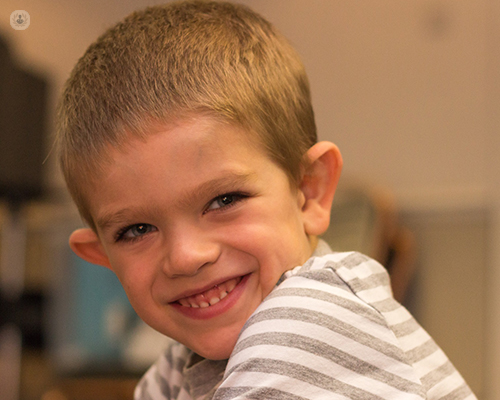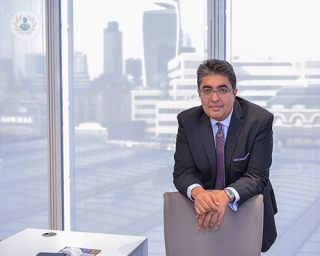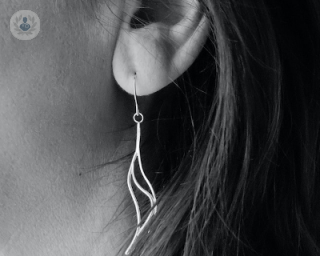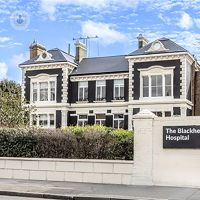What is otoplasty?
Otoplasty, which is also known as pinnaplasty, ear correction surgery or cosmetic ear surgery, is a surgical procedure to change the size, shape or position of the ears. Otoplasty is often associated with pinning ears back that appear as very protruding, so this is a common form of otoplasty carried out, but it is also known as pinnaplasty. Depending on the age of the patient, the intervention can be performed under general or local anaesthesia. Otoplasty can be carried out on children, but after the age of 5 years is recommended, as any younger and the ears will still be growing and developing. It is important to understand that otoplasty does not alter or affect your hearing, just the appearance of your ears.

Why is otoplasty done?
Otoplasty will be considered if your ears stick out a lot, if they appear as very large in proportion to your head, if you need to correct previous ear surgery, or if your ears have been damaged due to injury or congenital malformations.
What does otoplasty consist of?
Otoplasty can usually be carried out with local anaesthetic and is performed by either an otolaryngologist (ENT surgeon) or a plastic surgeon. A small incision is made behind the ear to gain access to the ear cartilage. Next, small sections of cartilage and skin are removed, depending on what results are being aimed for. Once done, the ear is positioned into place using scoring and stitching techniques. The whole procedure takes up to two hours. Newer techniques use special clips placed under the skin to reshape and reposition the ears.
Preparation for otoplasty:
Once you have been deemed healthy and suitable for surgery, your surgeon will advise you on any fasting required, which medications have to be stopped and any other requirements for having otoplasty. You will not be able to drive home after surgery, so making alternative arrangements beforehand will be necessary.
Aftercare:
Otoplasty is often carried out as a day-case procedure, meaning the patient can return home on the same day. You will have bandages around your ears after the procedure for protection. You may experience some itching and discomfort, but painkillers can manage this. It is important to avoid putting pressure on your ears, so try not to sleep on your side or rubbing your ears. Wearing loose-fitting collars is also advised for comfort.
Bandages should be worn during the day for the first few days, and afterwards just when sleeping for a couple of weeks. You should avoid swimming and other sports for several weeks to protect your ears. Stitches can be removed after 5-10 days, children can usually return to school after 1-2 weeks. Return to normal activities, such as swimming and contact sports can resume after 12 weeks.
11-13-2012 07-20-2023Otoplasty
Mr Ibrahim Albert Srouji - Otolaryngology / ENT
Created on: 11-13-2012
Updated on: 07-20-2023
Edited by: Conor Dunworth
What is otoplasty?
Otoplasty, which is also known as pinnaplasty, ear correction surgery or cosmetic ear surgery, is a surgical procedure to change the size, shape or position of the ears. Otoplasty is often associated with pinning ears back that appear as very protruding, so this is a common form of otoplasty carried out, but it is also known as pinnaplasty. Depending on the age of the patient, the intervention can be performed under general or local anaesthesia. Otoplasty can be carried out on children, but after the age of 5 years is recommended, as any younger and the ears will still be growing and developing. It is important to understand that otoplasty does not alter or affect your hearing, just the appearance of your ears.

Why is otoplasty done?
Otoplasty will be considered if your ears stick out a lot, if they appear as very large in proportion to your head, if you need to correct previous ear surgery, or if your ears have been damaged due to injury or congenital malformations.
What does otoplasty consist of?
Otoplasty can usually be carried out with local anaesthetic and is performed by either an otolaryngologist (ENT surgeon) or a plastic surgeon. A small incision is made behind the ear to gain access to the ear cartilage. Next, small sections of cartilage and skin are removed, depending on what results are being aimed for. Once done, the ear is positioned into place using scoring and stitching techniques. The whole procedure takes up to two hours. Newer techniques use special clips placed under the skin to reshape and reposition the ears.
Preparation for otoplasty:
Once you have been deemed healthy and suitable for surgery, your surgeon will advise you on any fasting required, which medications have to be stopped and any other requirements for having otoplasty. You will not be able to drive home after surgery, so making alternative arrangements beforehand will be necessary.
Aftercare:
Otoplasty is often carried out as a day-case procedure, meaning the patient can return home on the same day. You will have bandages around your ears after the procedure for protection. You may experience some itching and discomfort, but painkillers can manage this. It is important to avoid putting pressure on your ears, so try not to sleep on your side or rubbing your ears. Wearing loose-fitting collars is also advised for comfort.
Bandages should be worn during the day for the first few days, and afterwards just when sleeping for a couple of weeks. You should avoid swimming and other sports for several weeks to protect your ears. Stitches can be removed after 5-10 days, children can usually return to school after 1-2 weeks. Return to normal activities, such as swimming and contact sports can resume after 12 weeks.


Earfold vs. Otoplasty: how do these prominent ear correction techniques compare?
By Mr Santdeep Paun
2024-11-21
Leading facial plastic surgeon, Mr Santdeep Paun explains all about the new innovative procedure for correcting prominent ears, Earfold, and gives an overview of the difference compared with more traditional techniques. See more


Otoplasty: a step-by-step guide to the procedure
By Mr Anil Joshi
2024-11-21
Surgery to get your ears pinned back has evolved in recent years, and it’s now possible to reshape the ears without cutting the cartilage entirely. In this article, consultant ENT and facial plastic surgeon Mr Anil Joshi explains how modern surgeons approach ear surgery and what kind of recovery patients can expect. See more


ENT surgeon Mr Santdeep Paun - being a Top Doctor
By Mr Santdeep Paun
2024-11-21
Mr Santdeep Paun is a leading ENT (otolaryngology) surgeon who specialises in nasal and facial plastic surgery. He is based in a selection of well-known clinics across central London, including his clinics on Harley Street and at St Bartholomew’s Hospital. We spoke to Mr Santdeep Paun about why he chose to become a doctor and to become a specialist in ENT surgery. See more


Pinnaplasty: A procedure to correct prominent ears
By Mr Anil Joshi
2024-11-19
Revered consultant ENT and facial plastic surgeon Mr Anil Joshi gives an expert guide to what is involved in pinnaplasty procedures in this informative article for patients. See more
Experts in Otoplasty
-
Mr Santdeep Paun
Otolaryngology / ENTExpert in:
- Rhinoplasty (nose job)
- Septorhinoplasty
- Facelift
- Earfold®
- Nasal trauma
- Otoplasty
-
Mr Anil Joshi
Otolaryngology / ENTExpert in:
- Rhinoplasty (nose job)
- Endoscopic sinus surgery
- Otoplasty
- Facial plastic surgery
- Skin cancer
- Paediatric ENT
-
Mr Pundrique Sharma
Plastic surgeryExpert in:
- Breast augmentation
- Breast surgery
- Otoplasty
- Hand surgery
- Liposuction
- Tummy tuck (abdominoplasty)
-
Mr Philip Lim
Plastic surgeryExpert in:
- Breast surgery
- Body contouring
- Tummy tuck (abdominoplasty)
- Otoplasty
- Skin cancer
- Blepharoplasty
-
Mr Guy Thorburn
Plastic surgeryExpert in:
- Children's plastic surgery
- Vascular malformations
- Haemangioma
- Otoplasty
- Septorhinoplasty
- Birthmarks
- See all

London ENT Surgeons
London ENT Surgeons
10 Independents Road, SE3 9LF
No existe teléfono en el centro.
By using the telephone number provided by TOP DOCTORS, you automatically agree to let us use your phone number for statistical and commercial purposes. For further information, read our Privacy Policy
Top Doctors

London Bridge Hospital - part of HCA Healthcare
London Bridge Hospital - part of HCA Healthcare
27 Tooley St
No existe teléfono en el centro.
By using the telephone number provided by TOP DOCTORS, you automatically agree to let us use your phone number for statistical and commercial purposes. For further information, read our Privacy Policy
Top Doctors

The Blackheath Hospital - part of Circle Health Group
The Blackheath Hospital - part of Circle Health Group
40-42 Lee Terrace, Blackheath, London SE3 9UD
No existe teléfono en el centro.
By using the telephone number provided by TOP DOCTORS, you automatically agree to let us use your phone number for statistical and commercial purposes. For further information, read our Privacy Policy
Top Doctors
-
London ENT Surgeons
10 Independents Road, SE3 9LF, East LondonExpert in:
- Allergies nose and ears
- Plastic surgery, reconstructive and aesthetics
- Otology
- Otolaryngology
-
London Bridge Hospital - part of HCA Healthcare
27 Tooley St, Central LondonExpert in:
- 24-hour service
- Cardiology
- Minimal access surgery (keyhole surgery)
- Orthopaedic surgery
- Cardiovascular disease
- Gastroenterology
-
The Blackheath Hospital - part of Circle Health Group
40-42 Lee Terrace, Blackheath, London SE3 9UD, East LondonExpert in:
- Vascular Surgery
- Cardiology
- Bariatric Surgery
- Colorectal surgery
- Endocrine Surgery
- General Surgery
- See all
- Most viewed diseases, medical tests, and treatments
- Migraine
- Minimal access surgery (keyhole surgery)
- Head and neck cancer
- Neck lump
- Acellular dermal matrix (ADM)
- Prepectoral breast reconstruction
- One Stop Breast Clinic
- Botulinum toxin (Botox™)
- FUE hair transplant
- Carpal tunnel syndrome








